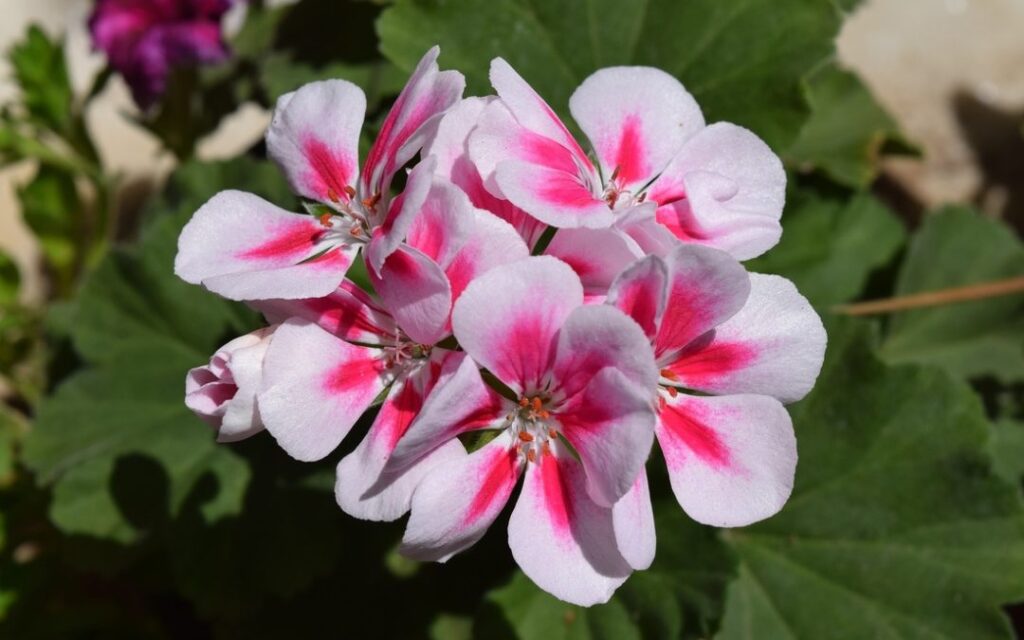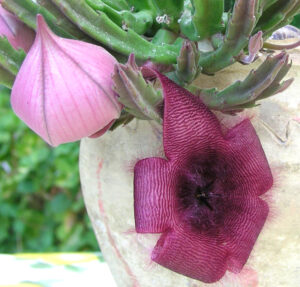By Patricia Jordan
Here we are again in high summer. Whilst holidaymakers love the Cyprus sunshine, those with gardens here know it is a time to keep a watchful eye on things. The masses of heavy rain we had during the winter meant that there was lots of growth on the plants and now with no rain at all, they droop very easily, even if watered in the cool of the day. Wells sometimes run dry around this time and as a result, some watering may have to be done with expensive town water, along with any that you are able to save from jobs indoors.
Some garden plants can look after themselves during this very hot period, having stored water in their fleshy stems and leaves. Aptemia is one of those ground-cover plants that can conceal areas that need some cover and its pretty little flowers started to appear last month.
Those with silvery leaves also do well, as the hairs on the reverse of the leaves cool the plants. The botanical name for this is hypoleuca, which means a dense covering of fine wooly hairs, protecting them from the hot earth underneath. Gazanias, with the same felted leaves, are natives of South Africa and are often planted as drought-tolerant ground-cover plants with their large flower heads of brilliant yellows and oranges. Grey-leaved Leucophyllum frutescens or the ‘Texas Ranger’, is ideal for hot gardens as the name would suggest. Any slight shower of rain or high humidity will cause the pretty rose-pink flowers to burst open.
In my garden a good ground-cover plant that always looks cool, is sold here under the name of Chrysanthemoides. This southern hemisphere plant is enhanced by yellow daisy-like flowers during late summer and into winter, hence the common name of ‘Daisy Bush’. The ubiquitous ‘Lamb’s Aars’, Stachys byzantina, also holds its own now.
Carpobrutus edulis, better known here as ‘Aphrodite’s Tresses’, but more widely known as the ‘Hottentot Fig’, is another good plant. The stems swell in the winter rains to sustain the plant in the summer heat. I usually recommend that it should be grown over unsightly banks or instead of grass, under trees or bordering paths. Aeonium arboreum is another plant that can endure hot weather, but by the end of the summer may look shrivelled and weary. After a few autumn showers it will perk up again. So when planning your garden include a few of these good plants.
WHAT TO DO IN THE GARDEN IN HIGH SUMMER
Pot plants are vulnerable and do need your assistance. Slow-release fertiliser is hard to find these days, but it is great for releasing the food gradually over a period of time to help sustain the plants. An alternative is to mix a measure of Phostrogen with the water in your watering can on a weekly or fortnightly basis and it should help to nourish your plants at this difficult time of the year. Move them into some shade for the next couple of months and they should survive.
Pelargoniums are excellent pots plants, originally from South Africa, but even so they need some dead-heading and some moisture every couple of days. Remember though that more plants die from over-watering than under-watering. Annuals with tiny roots near the surface will probably have died off already, so collect any seeds and save them for autumn planting. Most weeds will have died too by now, except for those with long tap roots able to search out any moisture deep down. You can see them thriving in fields lying bare after the harvest.
Insects are still around and new growth on wisteria may be attacked by black flies, which weren’t around earlier on and with citrus fruits finished for the moment, Mediterranean fruit flies will home in on any nectarines and peaches. The citrus leaf miner has certainly been around our garden, disfiguring new growth on the citrus leaves. Once the little grubs hatch out inside the leaves it is too late to do anything about them. The tree should be sprayed in late winter in order to keep away the moth that lays the eggs.
Climbers like hoya and stephanotis are soaring skywards in shaded spots, so make sure that they have some support so that they can climb away. Jasminum officinale and Cestrum nocturnum, more famously known as ‘Pakistani Nights’ because of its heady perfume, scent the night air and if you have planted them near a door or window you will enjoy their perfumes wafting in on the evening air. I understand that in former times here, jasmine flowers were threaded onto strings and worn on the head or around the neck, which perhaps kept more of the more unsavory smells at bay. Other climbers like Mandevillea splendens, known as the ‘Brazilian Jasmine’, with its lovely trumpet-shaped flowers in pinks, reds and whites, prefer more humid gardens but can grow equally well in a pot as in the ground. However, as they started out life in jungle surroundings, they are best grown out of our burning summer sun.

Pelargoniums
Canna lilies are tropical and sub-tropical plants with large banana-like leaves. They grow from rhizomes and again thrive in pots just as well as in the ground. They like plenty of heat, so grow them in full sun, but they can also tolerate partial shade. You may well see them growing in huge clumps in village gardens and although they are available in many colours these days, they tend to be only the red flowered ones you see locally. Don’t forget your indoor plants during this very hot time of the year. They can suffer from the heat and perhaps a dry atmosphere inside, so a little misting might be appropriate, but don’t water too much.
If you live in a rural area keep a lookout for any young snakes during these hot summer days. They like to lie on warm stones and drowse in the heat. They can also lurk under bushes and shrubs, so take care when clearing out old leaves from beneath them.
Add those dead leaves to your compost bins along with salad and veggie leavings and dead flower heads, but make sure that the layers are not too deep or compacted. It greatly benefits the heap if you can turn it over occasionally, but it is not a job for a hot day! By autumn, the contents should be ready to dig into your beds. Keep dead-heading your plants and as the flowers turn to seeds remember that a lot of them are far from nice. In fact some of them are downright poisonous! Every part of oleanders can be harmful and lantana berries, which look like ripe blackberries, are toxic.
A reminder that holiday times can be difficult here when houses are left empty from time to time. There are many opportunist thieves about, but if you make it difficult for them by locking away expensive furniture and equipment, they might just pass your house and garden by. Put your name or a code known only to you somewhere on them. If you have expensive pots or ornaments, take a photograph of them. Filling the bottom of the pots with big drainage stones as you plant them up, may hinder any thieves who try to remove them, although I have heard in some places in the UK, people have returned from holiday to find that their lawns have been dug up and taken away.
Enjoy the summer and don’t try to do too much in the garden, just keep it ticking over. It can all wait until the weather begins to cool down, which according to local custom should be after Maria’s Assumption on August 15th. So try and keep cool till then!
PLANT OF THE MONTH – STAPELIA
Stapelia is a genus of low-growing spineless, stem-succulent plants, predominately from tropical regions of South Africa with a few from other arid areas. The ‘stems’ contain fleshy tissues of water storage. The buds, which appear are pagoda shaped and quite attractive and when they burst open, they reveal a hairy, oddly textured and coloured flower.

Stapelia
These can be dull red or brown and generate the odour of rotten flesh when they are in full bloom. This awful smell attracts many flies that lay their eggs amongst the hairs, so the plants are best not placed near seating areas! The flowers can reach 41cm, but most are generally smaller around 15cm.
The seed pods are cylindrical and when ripe burst open revealing seeds, which rather like dandelions, float off in any breeze. Commonly known as ‘Carrion Plants’, ‘Starfish Flower Cactus’, ‘Rotten Plant’ and ‘Stinking Carrion’, despite their names they are good container plants and will grow well in full sun and light watering. They should be planted in well gritty drained compost as the stems are prone to rotting if kept moist too long.







Click here to change your cookie preferences